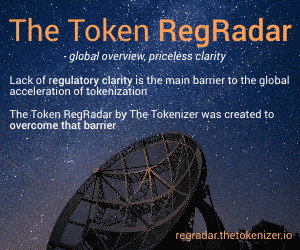Tokenization of Real Estate in the US
– an interview with the author of the latest expert report published by The Tokenizer
At The Tokenizer, we are happy to publish yet another expert report on tokenization – this time focusing on the regulatory side of real estate tokenization in the US. The report was written by our legal expert in the US, Tyler Passarella, and in this interview, I challenge him to explain and elaborate on some of his points.

Michael Juul Rugaard (MJR): – Real estate is one of the asset classes that gets the most attention when it comes to tokenization, but is it really that obvious to tokenize real estate? Traditional real estate investment methods have stood the test of time. Investors are well-acquainted with the processes; they understand the associated costs and risks. So, why fix what isn’t broken? Instead, shouldn’t we focus on applying tokenization to areas that genuinely need improvement or where we’re charting new territory?
Tyler Passarella (TP): – You make a great point – “if it ain’t broke, don’t fix it.” However, the same could have been said about the telegraph or the horse and buggy. The telegraph transmitted messages, and horse-drawn buggies provided transportation just fine without automobiles and telephones coming along. However, that analogy highlights how innovation, while risky at times, aims to optimize rather than “fix.” The car and telephone improved speed and accessibility over their predecessors. Similarly, tokenization aims to upgrade, not repair, real estate investing.
Innovation means trying new things and taking on new risks. And people have proven that they are willing to take risks so long as the benefits are proportionate. For example, when cars (and trains, for that matter) were invented, they were basically death traps. Yet people accepted that risk in order to get from point A to point B more efficiently. Big risk for a big benefit. So, the key is to find the appropriate risk-to-benefit balance, which inevitably will be different for everyone. Tokenization gives us new tools to make the current processes more efficient, transparent, and accessible – all valuable benefits worth considering. For some investors, the benefits go so far as opening up an entirely new asset class to invest in and potentially accumulate wealth through.
View and download your copy of The Tokenizer’s Tokenization of Real Estate report here:
Sure, the traditional model for real estate investment has worked well for those able to participate, which, in reality, is a small portion of the population. Tokenization offers the potential to upgrade the current model so it works well for all.
For one, tokenization can increase liquidity for traditionally illiquid assets such as real estate. By fractionalizing real estate into tokenized shares, owners gain the ability to more easily buy and sell portions of properties – reducing liquidity risk. Greater accessibility from lower investment minimums also helps spread risk across a broader investor base. Instead of just institutions for a select few, retail investors can get exposure through tokenized shares.
In essence, tokenization unlocks the potential to lower certain risks in real estate investing by opening it up to wider participation. And it could reduce costs through more streamlined and automated processes baked into the token’s smart contract.
Change inevitably meets resistance. This is especially true when it comes to processes that are deeply entrenched in the financial world, such as traditional real estate investing methods. And I agree with you – “if it ain’t broke, don’t fix it,” and at times, tokenization has seemed like a solution looking for a problem. However, this is not the case with real estate tokenization. This is an area that desperately needs to be brought into the 21st century, and tokenization can help facilitate this.
MJR: – our perspective in this report is primarily on the US real estate market, and in the US, two alternatives to direct ownership of real estate have been popular among investors who don’t have unlimited financial resources available or want to diversify their real estate portfolio and lower their risk. These alternatives are REITS (Real Estate Investment Trusts) and SPVs (Special Purpose Vehicles), which are types of companies structured to own real estate and to be owned by multiple investors. However, in the report, you argue that investing in tokenized real estate has more advantages for the investors than both REITS and SPVs. Why and how is that?
TP: – The main advantage of tokenized real estate is that it opens up investment opportunities to a much broader range of investors. With REITs, you typically need to meet large minimum investments and pay high management fees, essentially pricing out smaller investors.
With tokenized real estate, you can buy a small fraction of a property efficiently and for a low cost, increasing accessibility for average investors in a way it hasn’t been before. Liquidity is another big advantage. REITs can be highly illiquid, meaning investors can’t readily sell their shares when they want or need to. This exposes them to volatility risks, illiquidity premiums, and limits access to capital. Tokenized real estate is designed to be traded on secondary markets, enhancing liquidity and mitigating those risks.
SPVs have similar challenges with high investment minimums and SEC-imposed restrictions. Tokenization aims to remove those barriers so that anyone can invest in real estate on their own terms in a cost-effective way.
In short, tokenized real estate finally gives average investors the accessibility, liquidity, and profit potential that historically has been reserved for large institutions and the wealthy. It’s a significant step in the journey to democratize real estate investing.
MJR: – In the report, you suggest that the US looks to the tiny European country of Liechtenstein for regulatory inspiration, and I think it could make sense. The Tokenizer has closely followed the regulatory developments in Liechtenstein over the last couple of years, and Liechtenstein’s approach towards the regulation of tokens is quite innovative, and their idea of the so-called Token Container Model is unique. But how could you see this play out in practice? What exactly might the US learn from the Liechtenstein approach?
TP: – The key behind the Liechtenstein approach is the token container model that allows tokens to represent rights or assets that already exist under current laws. With real estate, a token could represent fractional ownership in a property and carry the same legal rights when transferred as traditional means. This makes sense when you consider that the underlying transaction (the transfer of ownership rights in the underlying property) has not changed at its core. What has changed is the mechanisms and technology that effectuate the transaction. This idea is commonly referred to as the “technology-neutral” approach; regulators look to the transaction and legal rights associated with the underlying asset as opposed to the technology or means by which the asset and associated rights are transferred.
This avoids the need to create whole new legislation for tokenized assets. For this approach to be successful in the US, we’d need to establish a similar role to Liechtenstein’s “Physical Validators” to confirm real-world transfers match on-chain activity. We’d also need clear guidelines for token issuers and exchanges to report activity and comply with regulations. However, the goal would be to fit token transactions as seamlessly as possible into our property ownership system.
In general, I think the container model allows innovation in tokenization to move forward organically without a complete overhaul of the existing legal system. It provides enough structure for validity but avoids over-prescribing to stifle innovation.
Read other stories: R3’s Corda Platform Powers Euroclear’s Historic Live Issuance of Digital Bond
The Tokenizer Launches New Report on Tokenization of Real Estate
You Might also Like












